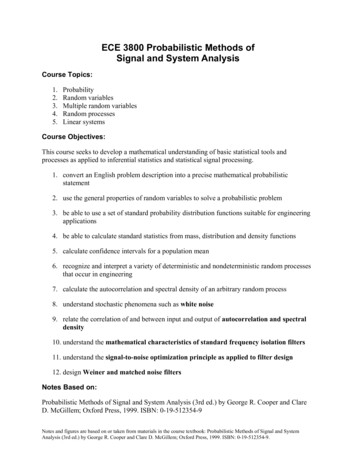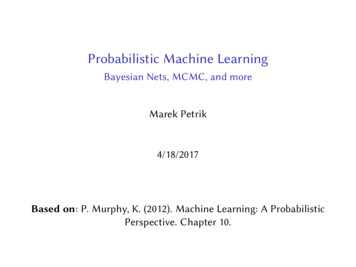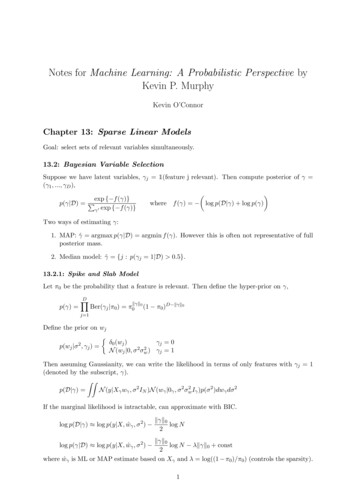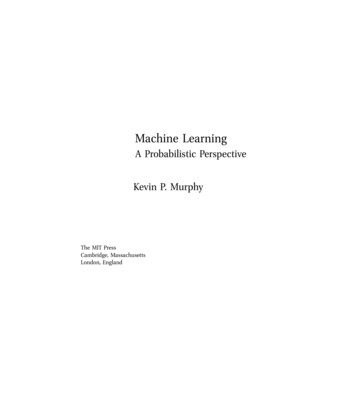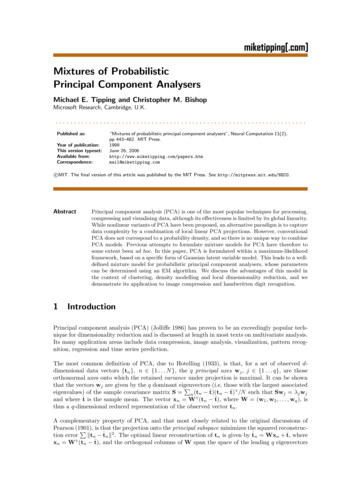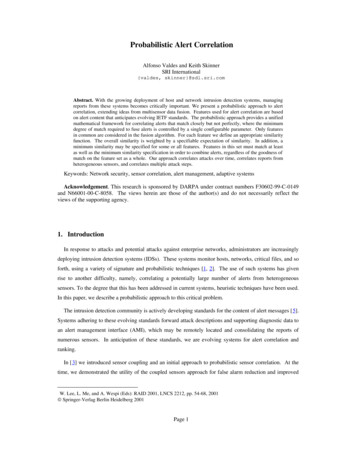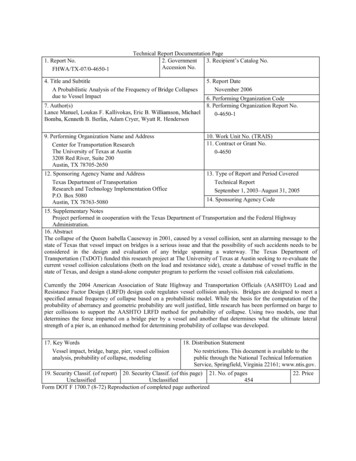
Transcription
1. Report No.FHWA/TX-07/0-4650-1Technical Report Documentation Page2. Government3. Recipient’s Catalog No.Accession No.4. Title and SubtitleA Probabilistic Analysis of the Frequency of Bridge Collapsesdue to Vessel Impact7. Author(s)Lance Manuel, Loukas F. Kallivokas, Eric B. Williamson, MichaelBomba, Kenneth B. Berlin, Adam Cryer, Wyatt R. Henderson5. Report DateNovember 20066. Performing Organization Code8. Performing Organization Report No.0-4650-19. Performing Organization Name and AddressCenter for Transportation ResearchThe University of Texas at Austin3208 Red River, Suite 200Austin, TX 78705-265010. Work Unit No. (TRAIS)11. Contract or Grant No.0-465012. Sponsoring Agency Name and AddressTexas Department of TransportationResearch and Technology Implementation OfficeP.O. Box 5080Austin, TX 78763-508013. Type of Report and Period CoveredTechnical ReportSeptember 1, 2003–August 31, 200514. Sponsoring Agency Code15. Supplementary NotesProject performed in cooperation with the Texas Department of Transportation and the Federal HighwayAdministration.16. AbstractThe collapse of the Queen Isabella Causeway in 2001, caused by a vessel collision, sent an alarming message to thestate of Texas that vessel impact on bridges is a serious issue and that the possibility of such accidents needs to beconsidered in the design and evaluation of any bridge spanning a waterway. The Texas Department ofTransportation (TxDOT) funded this research project at The University of Texas at Austin seeking to re-evaluate thecurrent vessel collision calculations (both on the load and resistance side), create a database of vessel traffic in thestate of Texas, and design a stand-alone computer program to perform the vessel collision risk calculations.Currently the 2004 American Association of State Highway and Transportation Officials (AASHTO) Load andResistance Factor Design (LRFD) design code regulates vessel collision analysis. Bridges are designed to meet aspecified annual frequency of collapse based on a probabilistic model. While the basis for the computation of theprobability of aberrancy and geometric probability are well justified, little research has been performed on barge topier collisions to support the AASHTO LRFD method for probability of collapse. Using two models, one thatdetermines the force imparted on a bridge pier by a vessel and another that determines what the ultimate lateralstrength of a pier is, an enhanced method for determining probability of collapse was developed.17. Key WordsVessel impact, bridge, barge, pier, vessel collisionanalysis, probability of collapse, modeling18. Distribution StatementNo restrictions. This document is available to thepublic through the National Technical InformationService, Springfield, Virginia 22161; www.ntis.gov.19. Security Classif. (of report) 20. Security Classif. (of this page) 21. No. of pagesUnclassifiedUnclassified454Form DOT F 1700.7 (8-72) Reproduction of completed page authorized22. Price
ii
A Probabilistic Analysis of the Frequency of BridgeCollapses due to Vessel ImpactLance ManuelLoukas F. KallivokasEric B. WilliamsonMichael BombaKenneth B. BerlinAdam CryerWyatt R. HendersonCTR Technical Report:Report Date:Project:Project Title:Sponsoring Agency:Performing Agency:0-4650-1November 20060-4650Vessel Impact on BridgesTexas Department of TransportationCenter for Transportation Research at The University of Texas at AustinProject performed in cooperation with the Texas Department of Transportation and the Federal HighwayAdministration.
Center for Transportation ResearchThe University of Texas at Austin3208 Red RiverAustin, TX 78705www.utexas.edu/research/ctrCopyright (c) 2007Center for Transportation ResearchThe University of Texas at AustinAll rights reservedPrinted in the United States of Americaiv
DisclaimersAuthor's Disclaimer: The contents of this report reflect the views of the authors, whoare responsible for the facts and the accuracy of the data presented herein. The contents do notnecessarily reflect the official view or policies of the Federal Highway Administration or theTexas Department of Transportation (TxDOT). This report does not constitute a standard,specification, or regulation.Patent Disclaimer: There was no invention or discovery conceived or first actuallyreduced to practice in the course of or under this contract, including any art, method, process,machine manufacture, design or composition of matter, or any new useful improvement thereof,or any variety of plant, which is or may be patentable under the patent laws of the United Statesof America or any foreign country.Notice: The United States Government and the State of Texas do not endorse products ormanufacturers. If trade or manufacturers' names appear herein, it is solely because they areconsidered essential to the object of this report.Engineering DisclaimerNOT INTENDED FOR CONSTRUCTION, BIDDING, OR PERMIT PURPOSES.Project Engineer: Lance Manuel, Ph.D., P.E.Professional Engineer License State and Number: Texas No. 95990P. E. Designation: Research Supervisiorv
AcknowledgmentsThe authors wish to acknowledge the financial support received from the TexasDepartment of Transportation (TxDOT) engineers that made this research project possible. Inaddition, they thank the following TxDOT engineers who served on the project team andprovided valuable assistance: Mark McClelland, P.E., Jody Ellington, P.E., and Jon Holt, P.E.Finally, the authors wish to express their gratitude to the production staff at the Center forTransportation Research and, in particular, Ms. Clair LaVaye, for their assistance in preparingthis report.vi
Table of ContentsIntroductionVolume I:Development of a Software Program for Vessel Impact Risk CalculationsVolume II: Vessel Impact ForcesVolume III: Ultimate Strength of Bridges Subjected to Vessel ImpactVolume IV: Development of a Database to Support Calculations on Vessel Impact Risksvii
viii
IntroductionThe collapse of the Queen Isabella Causeway in 2001, caused by a vessel collision, sentan alarming message to the state of Texas that vessel impact on bridges is a serious issueand that the possibility of such accidents needs to be considered in the design andevaluation of any bridge spanning a waterway. The Texas Department of Transportation(TxDOT) funded this research project at The University of Texas at Austin seeking to reevaluate the current vessel collision calculations (both on the load and resistance side),create a database of vessel traffic in the state of Texas, and design a stand-alone computerprogram to perform the vessel collision risk calculations.Currently the 2004 American Association of State Highway and Transportation Officials(AASHTO) Load and Resistance Factor Design (LRFD) design code regulates vesselcollision analysis. Bridges are designed to meet a specified annual frequency of collapsebased on a probabilistic model. While the basis for the computation of the probability ofaberrancy and geometric probability are well justified, little research has been performedon barge to pier collisions to support the AASHTO LRFD method for probability ofcollapse. Using two models, one that determines the force imparted on a bridge pier by avessel and another that determines what the ultimate lateral strength of a pier is, anenhanced method for determining probability of collapse is developed.Volume I Development of a Software Program for Vessel Impact RiskCalculationsBecause of the extensive calculations that need to be carried out to determine the returnperiod for just one bridge, a user-friendly stand-alone computer program, named VIOB(Vessel Impact On Bridges), is created. Using a comprehensive vessel traffic databasecreated for this research project, VIOB performs an entire bridge analysis efficiently.Like most analysis programs, VIOB consists of three parts: a pre-processing component,a solver component, and a post-processing component. A database assembled for theseanalyses is integrated with the software and is extensively used in the preprocessingphase. The solver component is where the various calculations leading up to theestimation of probability of bridge collapse are carried out. In the post-processingcomponent, results can be viewed and extensive reports can be printed and studied.In order to carry out all the calculations involved in estimating the probability of bridgecollapse due to vessel impact, the software program developed here builds upon vesselimpact force analysis, bridge ultimate strength analysis, and the development of adatabase on waterways, vessels, traffic, and bridges.A comprehensive study entitled, “Structural Reliability Analysis for Vessel Impact onBridges,” by Kenneth B. Berlin and Lance Manuel, summarizes all of the work carried1
out that relates to the structural reliability analysis and the development of the computerprogram, VIOB, for vessel impact on bridges. This study makes up Volume I of thisreport.Volume II Vessel Impact ForcesThe 2001 Interim AASHTO LRFD Bridge Design Specifications contain designprovisions that account for waterway vessel collisions on bridge piers and that wereadapted from the 1991 AASHTO Guide Specifications and Commentary for VesselCollision Design of Highway Bridges. Recent vessel collisions with bridge piers,however, have brought renewed attention to the code specifications, especially in light ofthe fact that the 1991 AASHTO Specifications draw heavily from two sets of physicalexperiments conducted 2 to 4 decades ago, which may not be representative of actualfield conditions and may lead to either conservative or inadequate designs.Among the various aspects of the design specifications, the way in which one estimatesthe impact force that the bridge piers will experience during a collision is clearly ofsignificance in the overall design process. In the current specifications, the impartedforce is computed through simplified kinetic energy arguments that require a prioriknowledge or an estimate of the vessel bow deformation. The estimated energy is thentransformed to an equivalent static force that is used for design. Such a process, thoughdesigner-friendly due to its simplicity, overlooks, among other issues, the dynamicbehavior inherent in an impact problem.It is therefore the purpose of this research to provide the framework for obtaining rationalestimates of the impact forces a pier may experience during a collision with a waterwayvessel. In the absence of a (costly) large-scale experimental program that will allow afield-based comparison of the design provisions, the only path to such estimates isthrough computational simulations. To this end, this study reports on the finite-elementbased modeling of collision events and provides, for a representative field scenario, acomparison between the AASHTO code provisions and the computational results.A comprehensive study entitled, “Modeling of Waterway Vessel Impact on Bridge Piers,”by Adam J. Cryer and Loukas F. Kallivokas, summarizes all of the work carried out thatrelated to vessel impact forces. This study makes up Volume II of this report.Volume III Ultimate Strength of Bridges Subjected to Vessel ImpactThe AASHTO-recommended design procedure for vessel collision is a probability-basedcalculation that returns an annual frequency of collapse for a given bridge. One of theimportant calculations in estimating the annual frequency of collapse is the ultimatelateral strength of a bridge element, which AASHTO defines as that of a bridge pier orbridge span. The current AASHTO Design Specifications provide little guidance in thecalculation of this value. An objective of one part of this study is to provide engineerswith the necessary tools to calculate the ultimate lateral strength of bridge elements. Thisstudy outlines procedures for modeling and analyzing bridge piers and bridge systems2
subject to vessel impact loads using a typical structural analysis software package. Themethods presented focus on modeling reinforced concrete bridge piers, both with andwithout shear walls. In addition, the effect of considering system-wide response on theultimate lateral strength of a bridge is investigated by including the bridge superstructureand adjacent bridge piers in the models.A comprehensive study entitled, “Modeling and Analysis of Bridges Subjected to VesselImpact,” by Wyatt R. Henderson and Eric B. Williamson, summarizes all of the workcarried out that related to ultimate strength of bridges subjected to vessel impact. Thisstudy makes up Volume III of this report.Volume IV Development of a Database to Support Calculations on VesselImpact RisksAs part of this research study, a significant effort is undertaken to collect the datarequired by the research engineers so that they can estimate the probability and the effectof vessel collisions on bridges along the Gulf Intracoastal Waterway and Texas’ inlandwaterways using the most realistic dataset that could be produced. The data assembledfor this study include information on vessel types (barges, towboats, barge groups, andships), waterways (including the GIWW, the Houston Ship Channel, the Neches Riverand the Victoria Barge Canal), a selected number of bridges and vessel traffic density intwo directions there, digital aerial photographs for geometric information on waterwaytransitions at the bridges, and current velocity data. Actual data is supplemented withsimulated information based on realistic assumptions when necessary.A comprehensive study entitled, “Data Collection for the Model for Vessel Impact onBridges,” by Michael Bomba, summarizes all of the work carried out that development ofthe database to support vessel impact risk calculations. This study makes up Volume IVof this report.3
4
Structural Reliability Analysis for Vessel Impact on BridgesKenneth B. BerlinLance ManuelCTR Technical Report:Report Date:Project:Project Title:Sponsoring Agency:Performing Agency:Volume IMay 20050-4650Vessel Impact on BridgesTexas Department of TransportationCenter for Transportation Research at The University of Texas at AustinProject performed in cooperation with the Texas Department of Transportation and the Federal HighwayAdministration.i
ii
Executive SummaryThe collapse of the Queen Isabella Causeway in 2001 due to a vessel collision was an alarmingmessage to the state of Texas that vessel impact on bridges is a serious issue and may need to beconsidered for all bridges that span waterways. The Texas Department of Transportation fundedthis research project that was aimed at examining in detail the AASHTO LRFD code provisionsfor vessel impact on bridges. The goals of the present study are to develop a stand-alonecomputer program that utilizes information on waterways, vessels, traffic, and bridges in aprobabilistic analysis that estimates the annual frequency of collapse.According to today’s code provisions for vessel impact on bridges, a bridge is required to have aspecific minimum return period associated with collapse depending on its importanceclassification. A user-friendly stand-alone computer program, VIOB (Vessel Impact onBridges), is developed to make it possible to carry out the required calculations that lead toestimates of the return period.Given information related to the bridge and pier geometry, the waterway, and the vessel traffic ata given mile marker of a waterway where the bridge is located, VIOB produces an in-depthreport detailing all the calculations. This report provides information on the analysis performedand also includes summaries that allow the user to determine sources of vulnerability for thebridge. Such information is useful in improving a bridge design when, for example, codespecifications are not met. VIOB integrates databases with analysis capabilities and makes itpossible to carry out calculations related to an important problem – the safety of bridges againstvessel impact.iii
iv
Table of ContentsChapter 1. Introduction. 11.1 Background.11.1.1 Bridge ultimate strength models . 41.1.2 Finite element modeling to assess impact forces . 41.1.3 Data Collection . 41.1.4 Structural Reliability Analysis . 41.2 Scope of Report .41.3 Organization of Report .5Chapter 2. Literature Review . 72.1 Previous Vessel Impact Studies.72.2 Changes in the Design Code.82.2.1 The 1991 AASHTO Guide Specification and Commentary for Vessel CollisionDesign of Highway Bridges. 92.2.2 The 2004 AASHTO LRFD Bridge Design Specifications . 9Chapter 3. The AASHTO Specifications for Vessel Impact on Bridges. 113.1 Implementation of AASHTO Guide Specification.113.1.1 Annual Frequency of Collapse. 113.1.2 Probability of Aberrancy (PA) . 12Aberrancy Base Rate. 13Correction for Bridge Location. 13Correction for Current. 14Correction Factor for Vessel Traffic Density . 15Limitations . 153.1.3 Geometric Probability (PG) . 16Limitations . 183.1.4 Probability of Collapse (PC). 18Ultimate Lateral Pier Strength . 19Vessel Impact Force. 19Limitations . 233.2 AASHTO LRFD Code Limitations .233.2.1 Data Limitations. 243.3 Conclusion .24Chapter 4. Modifications to the AASHTO LRFD Approach . 254.1 Areas of Modification.254.2 Modification Procedure .254.2.1 Test Variables . 25Variability of Material Properties . 25Variability of the Angle of Impact. 26Variability of Height/ Elevation of Impact . 26Variability of Vessel Loading. 27v
Variable Limitations . 274.2.2 A Proposal for Improved Probability of Collapse Calculations . 27Chapter 5. Example Calculations. 295.1 Calculation Method.295.2 The Colorado River - FM 521 Bridge .295.2.1 Description of Data . 29Bridge and Channel Diagrams . 29Bridge Data . 31Channel Data. 32Vessel Traffic Data . 325.2.2 Calculations. 34Probability of Aberrancy (PA). 34Geometric Probability (PG) . 37Probability of Collapse (PC). 37Vessel Frequency (N) . 39Return Period . 395.3 San Jacinto River – Eastbound IH-10 Bridge.405.3.1 Description of Data . 40Bridge and Channel Diagrams . 41Bridge Data . 42Channel Data. 43Vessel Traffic Data . 435.3.2 Calculations. 44Probability of Aberrancy (PA). 44Geometric Probability (PG) . 46Probability of Collapse (PC). 46Vessel Frequency (N) . 47Return Period . 475.4 Conclusions.48Chapter 6. Discussion of Results. 496.1 Bridge Performance and Recommendations.496.1.2 Colorado River – FM 521 . 496.1.3 San Jacinto River – IH 10 . 536.1.4 GIWW – PR 22 (Nueces County). 57Chapter 7. VIOB (Vessel Impact on Bridges) . 637.1 Introduction to the Software Program, VIOB.637.1.1 Past Vessel Impact Tools . 637.1.2 The Program VIOB and its Features. 637.2 User Flow Chart.637.3 Description of Program.657.3.1 Preprocessor . 65Start Menu. 65Main Page . 67Edit Bridge Information. 71Edit Pier Information . 72vi
Edit Channel Information . 75Understanding the Vessel Database. 767.3.2 Solver . 87Run Analysis. 877.3.3 Postprocessor . 89View Detailed Results. 89View Calculations. 91Compare Results . 91Print Report. 917.4 VIOB Conclusion .93Chapter 8. Conclusions. 958.1 Summary of Research.958.2 Recommendations for Future Research.96References. 97Appendix A Description of VIOB Database Tables. 99Appendix B VIOB Example. 105Appendix C Sample VIOB Report.123vii
viii
List of FiguresFigure 1.1: The Queen Isabella Causeway Collapses in September 2001 en1.html). 1Figure 1.2: The Collapsed Portion of the Queen Isabella Causeway (Source: SouthTexas Business Directory). . 2Figure 1.3: Bridge in Webbers Falls Oklahoma Collapses Due to Vessel Collision(Source: The Anniston Star). . 3Figure 2.1: 1980 Sunshine Skyway Bridge Collapse (Source: Time Magazine). . 8Figure 3.1: Channel turn region (from AASHTO LRFD Figure 3.14.5.2.3-1a) . 13Figure 3.2: Channel bend region (from AASHTO LRFD Figure 3.14.5.2.3-1b) . 14Figure 3.3: Normal distribution curve for geometric probability. (AASHTO LRFDcode Figure 3.14.5.3-1).
lateral strength of a bridge element, which AASHTO defines as that of a bridge pier or bridge span. The current AASHTO Design Specifications provide little guidance in the calculation of this value. An objective of one part of this study is to provide engineers with the necessary tools to calculate the ultimate lateral strength of bridge elements.


